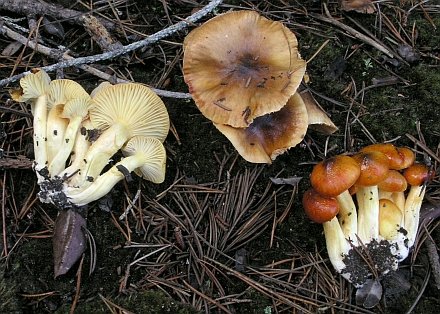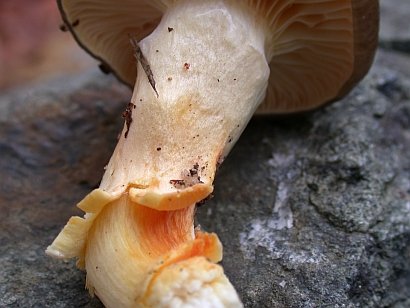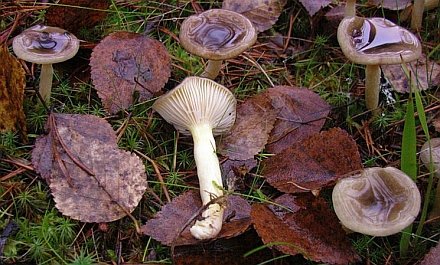The herald of winter, Hygrophorus hypothejus (Fr.) Fr. Note the particularly viscid involue caps.

Synonyms
Agaricus hypothejus Fr.
Observ. mycol. (Havniae) 2: 10 (1818)
Hygrophorus aureus Arrh.
Monogr. Hymenomyc. Suec. (Upsaliae) 2: 127 (1863)
Hygrophorus hypothejus var. aureus (Arrh.) Imler
Bull. trimest. Soc. mycol. Fr. 50: 304 (1935) [1934]
Hygrophorus hypothejus var. expallens Boud.
Icones Mycologicae (Paris) 1: pl. 33 (1905)
Limacium hypothejus (Fr.) P. Kumm.
(1871)
Common names
Olive-brown waxy cap
Winter herald
Late fall waxy cap
Pine-wood hygrophorus
Denneslijmkop (Dutch)

My name is Austin Collins.
I've dedicated my life to Mushrooms.
I believe Mushrooms are the best kept secret when it comes to health and well being.
For that reason, I would like to share a company with you that in my opinion makes the best mushroom products on the market.
The company is called Noomadic Herbals, my favorite supplement they make is called "Mushroom Total".
I take their products every day and they have helped me think better and have more energy. Give them a try.
-Austin
Description
Cap: 3-7 cm diameter, initially convex to broadly umbonate, later plano-convex, or depressed; surface smooth, glutinous when wet; color variable: typically dark brown to olive-brown at the center and more pallid at the margin when young (but sometimes entirely olive-brown, see links section for examples), often developing yellow-orange to reddish-orange tones in age, especially near the margin; margin involute when young.
Gills: decurrent to subdecurrent, adnate in young specimens, fairly distant (8-11 per cm), thick, soft, waxy, initially pallid, later pale yellow.
Stem: 2-6 cm tall, 0.5-1.5 cm diameter, equal or tapered downward; yellow at apex, otherwise pallid or variously colored (like cap) and slimy when moist.
Veil: evanescent, leaving slime on stalk and sometimes a fibrillose ring.
Spore print: white.
Spores: elliptical to oval, smooth, hyaline, non-amyloid, 7-10 x 4-5 µm.
Flesh: thin, pale yellow, bruising orange-yellow, as shown below.

Odor and taste: not distinctive.
Edibility: edible but bland.
Habitat: scattered to gregarious or in troops under conifers, especially pine; widely distributed and often abundant in cool weather, especially late fall to early winter.
This mycorrhizal mushroom thrives in cooler weather, and as its common names suggest, often does not fruit until after the first frost of the season. According to Bas et al., 1990 (p. 128), H. hypothejus var. hypothejus differs from var. aureus in having an olive-brown to red brown central cap coloration cap rather than orange-red.
Biochemistry
Elo et al. (1951) first reported that the extract of H. hypothejus had ABD hemagglutination specificity. More recently, further research led to the isolation of a lectin (named HHL) with an agglutination specificity of A and B blood group erythrocytes (Veau et al., 1999). In hemagglutination inhibition assays, HHL has a sugar-binding specificity toward lactose.
Interestingly, the otherwise common polar lipid phosphatidylcholine (PC) is noticeably absent in this species, but present in other members of the genus (Vaskovsky et al., 1998). However, this mushroom does contain a significant amount of the betaine lipid 1,2-diacylglyero-O-4′-(N,N,N,-trimethyl)homoserine (DGTS), thought to have biochemical functions similar to PC.
Medicinal properties
Antitumor effects
Polysaccharides extracted from the mycelial culture of H. hypothejus and administered intraperitoneally into white mice at a dosage of 300 mg/kg inhibited the growth of Sarcoma 180 and Ehrlich solid cancers by 70% and 80%, respectively (Ohtsuka et al., 1973).
Links
Both Fungi of Poland and Fungi of California have pictures and descriptions. A number of photos at BioPix further demonstrate the variations in cap color observed in this species.
References
Bas C, Kuyper TW, Noordeloos ME, Vellinga EC. 1990
Flora agaricina neerlandica. Vol. 2.
CRC Press. 144 pp.
Guillot J, Coulet M.
Studies on anti (A+B) lectin of Hygrophorous hypothejus Fr. Fixation, elution, inhibition.
Rev Fr Transfus. 1974 17(1):49-57.
Ohtsuka S, Ueno S, Yoshikumi C, Hirose F, Ohmura Y, Wada T, Fujii T, Takahashi E.
Polysaccharides having an anticarcinogenic effect and a method of producing them from species of Basidiomycetes.
UK Patent 1331513, 26 September 1973.
Vaskovsky VE, Khotimchenko SV, Boolukh EM.
Distribution of diacylglycerotrimethylhomoserine and phosphatidylcholine in mushrooms.
Phytochem. 1998 47(5):755-60.
Veau B, Guillot J, Damez M, Dusser M, Konska G, Botton B.
Purification and characterization of an anti-(A+B) specific lectin from the mushroom Hygrophorus hypothejus.
BBA-Gen Subjects. 1999 1428(1):39-44.


